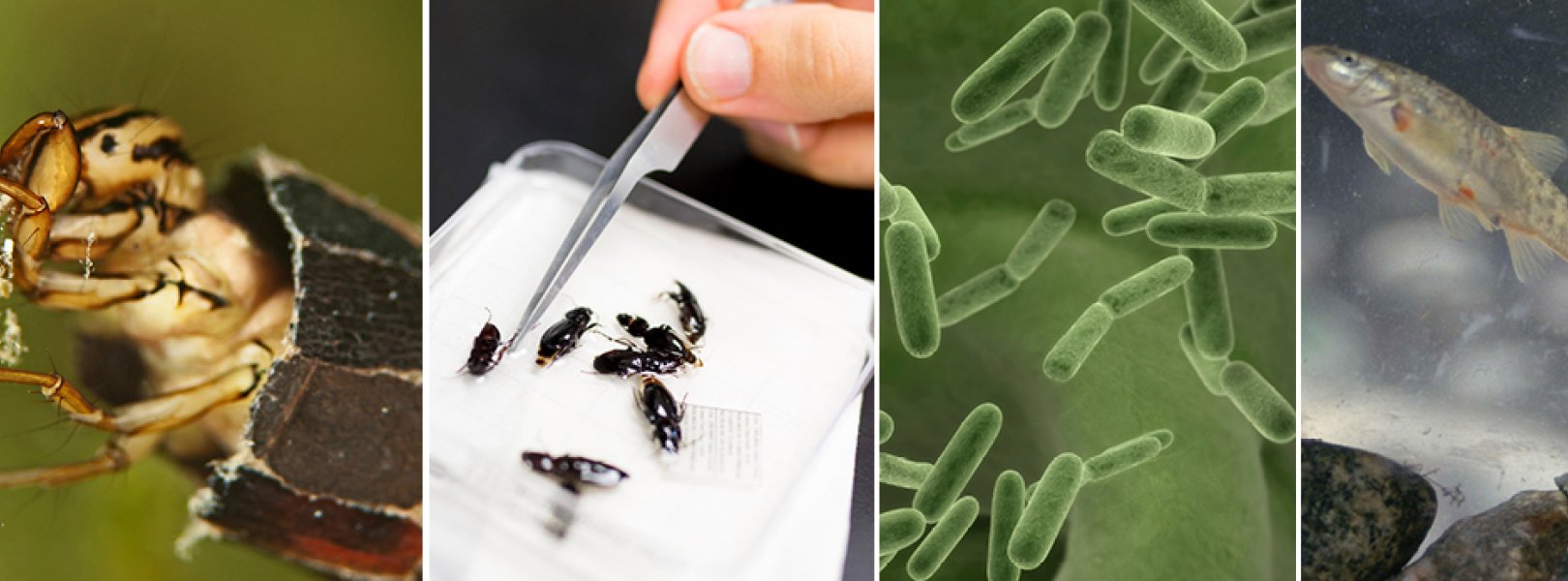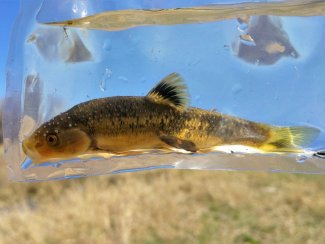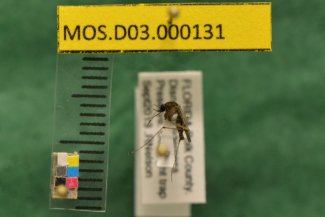DNA Sequences

The vast amount of biodiversity on Earth cannot be detected with the naked eye, yet even macro-organisms can harbor diversity that is not readily observable. This so-called cryptic diversity can be detected using DNA-based methods. By targeting specific portions of the genomes that make up different species of plants, animals, and microbes, a more complete picture of biodiversity can be obtained. These DNA 'fingerprints' also can be used to cross-check visual species identifications and help ensure consistency in taxonomic data sets over time. They may also detect evolutionary processes - such as speciation - while they are happening, because changes in the DNA of a population may be evident much sooner than any visual changes can be measured.
Looking beyond DNA fingerprinting, DNA provides insights into ecosystem functioning. For example, whole-genome shotgun DNA sequencing can determine the DNA sequences of entire genomes by randomly selecting fragments of DNA from a complex environmental sample. This method can detect the presence of entire communities, as well as the genes coded for in the genomes of those communities. Such information can be used to understand how biogeochemical processes such as nitrogen cycling are related to gene functions and community structure. And because shotgun DNA sequencing does not target any organism or gene in particular, it can detect novel diversity, gene functions, and even viruses that are present in the environment.
During observational sampling bouts of certain organisms, NEON field ecologists select a subset of aquatic and terrestrial organisms that receive genetic analysis. The resulting genomic extracts of many of the samples are also archived into the NEON Biorepository. DNA analysis serves several purposes, including verification of taxonomy of specimens that do not receive expert identification, clarification of the taxonomy of rare or cryptic species, characterization of diversity using molecular markers, and functional gene characterization. DNA sequences of organisms vary by site type and include:
- Metacommunity sequences of environmental samples, particularly from surface water, benthic samples, and terrestrial soils
- Metacommunity sequences of macroinvertebrate samples and zooplankton samples
- DNA barcoding of tissue from individual organisms; target taxa are fish, ground beetles, mosquitoes, and small mammals
Shotgun Metagenome Sequences
The following data products are created from collected samples that are frozen on dry ice and shipped to an analytical facility for DNA extraction, sample preparation, shotgun metagenomic sequencing, and high-throughput sequence analysis using primer sets targeting the small subunit of the ribosomal RNA gene.
Benthic Microbe Marker Genes and Metagenomes
Site Type: Streams
Benthic microbe samples are collected at the same time and location as periphyton samples three times per year in wadeable streams during aquatic biology bout windows, roughly in spring, summer, and fall. Samples are scrubbed from rock surfaces (epilithon) and filtered, or collected from the sediments (epipsammon, epipelon) or plant surface (epiphyton). A duplicate set of filtered samples collected from rock scrubs are sent to the NEON Biorepository.
Surface Water Microbe Marker Genes and Metagenomes
Site Type: Streams, Rivers, Lakes
Surface water microbe samples are collected at the same time and location as surface water cell count samples and surface water chemistry samples once per month in wadeable streams (12 times per year) and every other month in lakes and rivers (six times per year). In wadeable streams, surface water microbe samples are collected near the downstream surface water sensor location. In lakes and rivers, microbial samples are collected near the buoy-mounted sensor station, where sampling depth is dependent on stratification. At flow-through lakes, surface water microbes are also collected near the inlet and outlet sensors. A duplicate set of samples are sent directly to the archive facility.
Soil Microbe Marker Genes and Metagenomes
Site Type: Terrestrial
Soil sampling occurs annually during the historic peak in vegetation greenness at three randomly assigned base plots are terrestrial sites. Soil samples are collected to a maximum depth of 30 cm, with organic and mineral soils sampled separately. Subsamples of homogenized soil (rocks, roots, and organic debris removed) from each of the three sampling locations are combined to form a plot-level composite sample that is used for metagenomics analysis.
Metabarcodes
The following data products are created from samples that are shipped to an external facility for homogenization and high-throughput sequencing (metabarcoding) targeting two regions of the COI gene.
Macroinvertebrate Metabarcoding
Site Type: Streams, Rivers, Lakes
Benthic macroinvertebrate DNA samples are collected three times per year at wadeable stream, river, and lake sites during aquatic biology bout windows, roughly in spring, summer, and fall, at the same time and location as morphological taxonomy samples. Samples from the spring and fall bouts are shipped directly to the Biorepository. Macroinvertebrate samples are collected using the most appropriate sampler for the habitat type. In wadeable streams, samples are collected in the most dominant habitat type (e.g. riffles, runs, pools, step pools). In lakes and rivers, samples are collected in littoral areas. Samples are preserved in ethanol in the field and returned to the Domain support facility for a preservative change before shipping to an external facility. Samples from the mid-summer bout are used for DNA extraction and metabarcoding.
Zooplankton Metabarcoding
Site Type: Lakes
Zooplankton DNA samples are collected three times per year at lake sites during aquatic biology bout windows, roughly in spring, summer, and fall. Samples from the mid-summer bout are used for metabarcoding. Samples from the spring and fall bouts are shipped directly to the Biorepository. Samples are collected using a tow net (water deeper than 4 m) or a Schindler-Patalas trap (water shallower than 4 m) depending on the depth at the sampling location. Zooplankton samples are collected near the buoy-mounted sensor station, as well as the inlet and outlet sensor sets. Samples are preserved in ethanol in the field and returned to the Domain support facility for a preservative change before shipping to an external facility.
DNA Barcode Sequences

Live fish sample from a NEON site
The following data products are created from tissue samples that are shipped to an external lab for DNA extraction. Target sequences are amplified via PCR. Barcodes of cytochrome oxidase I are generated per specimen.
Fish DNA Barcodes
Site Type : Streams, Lakes
Fish sampling is conducted twice a year at most wadeable streams and lakes, roughly in the fall and spring. During each sampling bout, fin clips are taken from up to five specimens per species to be used for DNA barcoding. The primary objective for DNA barcoding fish is to elucidate cryptic and hybrid species as well as for taxonomic verification.
Ground Beetle DNA Barcodes
Site Type: Terrestrial
At each terrestrial site, ground beetle samples are collected biweekly throughout the growing season using pitfall traps. During these sampling bouts, a subset of beetle legs is collected from up to ten individuals per species per site. Up to 95 of these samples per site per year are used for DNA barcoding. Beetles that are rare, particularly difficult to identify, or poorly represented in previous collection events are prioritized for DNA sequencing. Only beetle specimens that have been identified by an expert taxonomist are eligible for DNA barcoding.

Pinned mosquito sample of Mansonia titillans
Mosquito DNA Barcodes
Site Type: Terrestrial
At each terrestrial site, mosquito samples are collected periodically throughout the active mosquito season using CO2 traps. During these sampling bouts, a subset of mosquito legs is collected from up to ten individuals per species per NEON Domain. Up to 95 of these samples per Domain per year are used for DNA barcoding.
Small Mammal DNA Barcodes
Site Type: Terrestrial
At terrestrial field sites, live trapping is conducted 4-6 times per year to collect small mammal observations. During these sampling bouts, up to 240 ear punches are collected from live specimens at each site per year. Up to 95 of these samples per Domain per year are used for DNA barcoding.
Data Products
Shotgun Metagenome Sequences
- Benthic microbe metagenome sequences (DP1.20279.001)
- Soil microbe metagenome sequences (DP1.10107.001)
- Surface water microbe metagenome sequences (DP1.20281.001)
Metabarcodes
- Macroinvertebrate metabarcoding (DP1.20126.001)
- Zooplankton metabarcoding (DP1.20221.001)
DNA Barcode Sequences
- Fish sequences DNA barcode (DP1.20105.001)
- Ground beetle sequences DNA barcode (DP1.10020.001)
- Mosquito sequences DNA barcode (DP1.10038.001)
- Small mammal sequences DNA barcode (DP1.10076.001)
Archival Samples
Shotgun Metagenome Sequences
Benthic Microbe Marker Genes and Metagenomes
NEON archives unprocessed Sterivex filters (suitable for researchers to process for genetic analyses) in addition to genomic extracts that remain after DNA sequencing is complete. See the aquatic microbes data collection page for a high-level summary. Archival samples of water collected at NEON aquatic field sites are available from the NEON Biorepository.
| Types of Samples* | Storage Condition | Storage Container | Quantity Archived (Annually) † | Link to the Collection |
|---|---|---|---|---|
| Aquatic microbial samples, benthic | -80°C | Sterivex filters | 360 to 440 samples | Benthic Microbe Collection (Sterivex Filters) (NEON-BEMC-SF) |
| DNA extracts from benthic samples | -80°C | 96-well plates‡ | 600 to 800extracts | Benthic Microbe Collection (DNA Extracts) (NEON-BEMC-DNA) |
Surface Water Microbe Marker Genes and Metagenomes
NEON archives unprocessed Sterivex filters (suitable for researchers to process for genetic analyses) in addition to genomic extracts that remain after DNA sequencing. See the aquatic microbes data collection page for a high-level summary. Archival samples of water collected at NEON aquatic field sites are available from the NEON Biorepository.
| Types of Samples* | Storage Condition | Storage Container | Quantity Archived (Annually) † | Link to the Collection |
|---|---|---|---|---|
| Aquatic microbial samples, surface water | -80°C | Sterivex filters | 300 to 400 samples | Surface Water Microbe Collection (Sterivex Filters) (NEON-SWMC-SF) |
| DNA extracts from surface water collection | -80°C | 96-well plates‡ | 250 to 400 extracts | Surface Water Microbe Collection (DNA Extracts) (NEON-SWMC-DNA) |
Soil Microbe Marker Genes and Metagenomes
Archival soil samples collected from NEON terrestrial field sites are available from the NEON Biorepository. Both organic and mineral horizons are archived if present at the site location. NEON archives unprocessed frozen soils (suitable for researchers to process for genetic analyses) in addition to genomic extracts that remain after DNA sequencing. See the soil microbe data collection page for a high-level summary.
| Types of Samples | Storage Condition | Storage Container | Quantity Archived (Annually) † | Expected Sampling Frequency | Link to the Collection |
|---|---|---|---|---|---|
| Soil, frozen | -80°C or -196°C | 2 oz. WhirlPak, 50 mL conical tubes, or 5 mL cryovials | 19,000 to 21,000 | annually at all terrestrial sites | Soil Microbe Collection (Bulk Subsamples) (NEON-SOMC-BS) |
| Genomic extracts, from soils | -80°C | 96-well plates‡ | 2,300 to 3,000 extracts | annually at all terrestrial sites | Soil Microbe Collection (DNA Extracts) (NEON-SOMC-DNA) |
Metabarcodes
Macroinvertebrate and Zooplankton Metabarcoding Archival Samples
All genomic extracts remaining after the metabarcoding analysis is complete are archived at the NEON Biorepository. In addition to samples that are directly related to the DNA sequence data on the portal, NEON also archives sorted and identified macroinvertebrates and bulk unsorted samples of macroinvertebrates that researchers can request if they want to do additional genetic analyses.
| Types of Samples | Storage Condition | Storage Container | Quantity Archived (Annually) † | Link to the Collection |
|---|---|---|---|---|
| DNA extracts from macroinvertebrates (summer) | -196°C | 2 mL cryovials | 90 to 110 samples | Benthic Macroinvertebrate Collection (DNA Extracts) (NEON-BMIC-DNA) |
| Macroinvertebrate, unsorted whole samples (spring and fall) | 70 to 95% ethanol | 500 mL jaror smaller | 180 to 220samples | Benthic Macroinvertebrate Collection (Unsorted Bulk Sample) (NEON-BMIC-UB) |
| DNA extracts from zooplankton (summer) | -196°C | 2 mL cryovials | 21 samples | Zooplankton Collection (DNA Extracts) (NEON-ZOOC-DNA) |
| Zooplankton samples, unprocessed (spring and fall) | 70% or 95% ethanol | 500 mL jar or smaller | 42 samples | Zooplankton Collection (Unsorted Bulk Sample) (NEON-ZOOC-UB) |
DNA Barcode Sequences
Fish DNA Barcodes
The NEON program archives both whole fish vouchers (some of which are DNA barcoded, but not always) and genomic extracts remaining from DNA barcode analysis. Both are available from the NEON Biorepository.
| Types of Samples* | Storage Condition | Storage Container | Quantity Archived (Annually) † | Link to the Collection |
|---|---|---|---|---|
| Fish, whole vouchers | 70% ethanol | individuals or lots | 450 to 700 samples | Fish Collection (Vouchers) (NEON-FISC-V) |
| DNA extracts from fish fin clips | -80°C | 96-well plates‡ | 475 to 570 extracts | Fish Collection (DNA Extracts) (NEON-FISC-DNA) |
Ground Beetle DNA Barcodes
All DNA extracts are archived at the NEON Biorepository. Legacy beetle vouchers are maintained at a few collections, but all beetle vouchers collected after 2018 are located at the NEON Biorepository.
| Types of Samples* | Storage Condition | Storage Container | Quantity Archived (Annually) † | Link to the Collection |
|---|---|---|---|---|
| Identified Ground Beetles, vouchers | dry | individuals mounted on pins or points | 12,000 to 16,000 individuals | Carabid Collection (Pinned Vouchers) (NEON-CARC-PV) |
| DNA extracts from vouchered beetles | -80°C | 96-well plates‡ | 2,900 to 3,000 extracts | Carabid Collection (DNA Extracts) (NEON-CARC-DNA) |
Legacy collection**:
| Archive Institution | Collection Years | Types of Samples | Storage Condition | Storage Container | Link to the Collection |
|---|---|---|---|---|---|
| Carnegie Museum of Natural History, Invert Zoology | 2013 – 2017 | Identified Ground Beetles, vouchers | dry | individuals mounted on pins or points | Carnegie Museum of Natural History Museum Invertebrate Zoology Collection |
| Essig Museum of Entomology at the University of California, Berkeley | 2013 – 2017 | Identified Ground Beetles, vouchers | dry | individuals mounted on pins or points | Essig Museum of Entomology (EMEC-EMEC) |
Mosquito DNA Barcodes
A subset of identified mosquitoes (up to 20 individuals of each species) is mounted on points as vouchers. DNA barcoding is performed on some of these vouchers; any surplus genomic extracts from this analysis are also archived.
| Types of Samples | Storage Condition | Storage Container | Quantity Archived (Annually) † | Link to the Collection |
|---|---|---|---|---|
| Identified Mosquitoes, vouchers | dry | individuals mounted on points | 2,000 to 2,400 individuals | Mosquito Collection (Pinned Vouchers) (NEON-MOSC-PV) |
| DNA extracts from vouchered mosquitoes | -80°C | 96-well plates‡ | 1,850 to 1,950 extracts | Mosquito Collection (DNA Extracts) (NEON-MOSC-DNA) |
Small Mammal DNA Barcodes
Both whole specimen and tissue samples are available for use from the NEON Biorepository. Samples may include preserved whole specimens (for trait analysis), ear punches, hair and whisker samples, biological tissues (skin, organs), and feces. Some samples are available for destructive purposes and others for non-destructive research purposes only. NEON also archives small mammal DNA extractions.
| Types of Samples* | Storage Condition | Storage Container | Quantity Archived (Annually) † | Link to the Collection |
|---|---|---|---|---|
| Blood samples | -196°C | 2 mL cryovials | 1,600 to 2,100 vials | Mammal Collection (Blood Samples) (NEON-MAMC-BL) |
| Ear tissue | -196°C | 2 mL cryovials | 450 to 550 samples | Mammal Collection (Ear Tissue) (NEON-MAMC-EA) |
| Genomic extracts, from pathogen testing | -196°C | 2 mL cryovials | 500 to 5,475 vials | NEON Biorepository |
| DNA extracts from ear tissue | -80°C | 96-well plates‡ | 1,850 to 1,950 extracts | Mammal Collection (DNA Extracts) (NEON-MAMC-DNA) |
| Fecal samples | -196°C | 2 mL cryovials | 4,500 to 9,600 samples | Mammal Collection (Fecal Samples) (NEON-MAMC-FE) |
| Hair and Whiskers | dry | archival coin envelopes | 3,200 to 5,800 samples | Mammal Collection (Hair Samples) (NEON-MAMC-HA) |
| Small mammals, whole vouchers | Frozen dry or 95% ethanol | individual or lots | 600 to 900 individuals | Mammal Collection (Vouchers [Standard Sampling at Pathogen Plots]) (NEON-MAMC-VPP) |
Legacy collections**:
| Archive Institution | Collection Years | Types of Samples | Link to the Collection |
|---|---|---|---|
| Museum of Southwestern Biology at the University of New Mexico | 2013-2017 | blood, ear tissue, feces, hair & whiskers, whole vouchers | Museum of Southwestern Biology - Mammal specimens (MSB-MAMM) |
| Florida Museum of Natural History | 2013 - ongoing | mammal vouchers [only specimens collected from Florida] | Florida Museum Mammalogy Collection |
* Select specimens collected from 2013-2017 and most specimens collected after 2018 are archived at the NEON Biorepository at Arizona State University. See table below for information about the archive locations of early (2013-2017) material.
† Quantities represented in this table are annual quantities expected from sampling conducted throughout the Observatory during full Operations. Actual quantities (particularly from years in early construction) will differ from these projections
‡ Quantities are number of samples (not number of well plates); up to 96 samples are contained on the same well plate
** Some legacy material is curated at other institutions, where material was archived before the creation of the NEON Biorepository. NEON is required to continue archiving some materials (e.g., mammal specimens collected in Florida) at these institutions due to permitting requirements that specify certain material must reside in the state where it was originally collected.